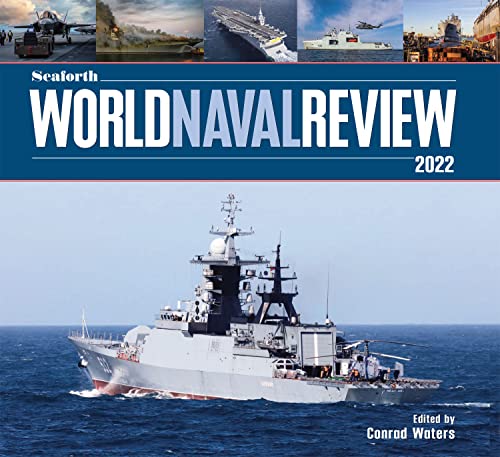
Seaforth Naval Review 2022. Edited by Conrad Waters. Seaforth Publishing 2022.
Reviewed by John Mortimer
BUY NOW FROM BOOKTOPIA
The 2022 edition of World Naval Review retains its traditional format of an Overview, followed by a section on World Fleet Reviews which comprises a mix of world regions coupled with individual fleet reviews, the latter include the Sri Lanka, Spain and Royal navies.
This is followed by a section on significant ships, which focuses on OPV, corvette and replacement of the USN LCAC. Discussion of the ships is quite detailed and provides a good insight into their genesis, capabilities and characteristics. The final section comprises technological reviews covering naval aviation, electro optics at sea and a new model for mine countermeasures. Authors, in addition to the editor, comprise many specialists in their fields, and include Norman Friedman, David Hobbs, Richard Scott and Mrityunjoy Mazumdar.
World Naval Review covers naval developments over the past 12 months and draws on official statements of policy or reports, where available in discussing regional or specific navy issues. This book is now well established as an affordable annual overview of naval policy and developments. The book’s coverage complements that of the more expensive annual “Janes Fighting Ships,” especially in terms of its strategic perspectives and detailed coverage of individual ships.
Australia is discussed as a major regional power and it is noted that:
“In July 2020, Australia’s government released two major upgrades of its 2016 Defence White Paperwith publication of its 2020 Defence Strategic Update and 2020 Force Structure Plan.… the new documents stated that the strategic environment had deteriorated more rapidly than anticipated. The key fear is China’s increased use of coercive activities…. The response will be greater focus of resources on Australia’s ‘near region’ and a sustained commitment to expanding military capabilities by extending planned increase in defence spending throughout the course of the next decade.”
In terms of new ships for the Royal Australian Navy mention is made of the delivery of the afloat support ships Supply and Stalwart, the OPVs, Hunter class frigates, and the Attack class submarines (this latter program has since been cancelled). It is also observed, in relation to major surface combatants that there have been no significant changes since the Hobart class destroyer deliveries.
David Hobb’s discussion of naval aviation observes that:
“Even though no decision has been taken to procure STOVL Lightnings for operation from the RAN’s ski-jump equipped Canberra and Adelaide, the fact that – by the late 2020’s – F-35Bs will be operated by the UK, USA, Japan and South Korea in the Pacific must make the procurement of a batch of ‘B’ models attractive…. They would achieve greater strategic effect than a larger number of F-35As flying localised sorties from an airfield in Australia.”
While such an acquisition of F-35Bs might have intuitive attraction if it were to be pursued it would likely be at the expense of the ships amphibious and strategic sealift capabilities.
The Bouchard and River class OPVs have been built to provide essentially for constabulary tasks for the Argentine and Royal navies, respectively. Both vessels are relatively large at 1,650 tons and 2,000 tons full load displacement. The Argentine vessel is also fitted to carry a light helicopter while the River class can land on helicopters up to Merlin size. Both ships main armament comprises a 30mm light gun. The River class ships carry the interesting title of ‘Colonial Gunboats’ which is no doubt a reflection of their employment in part on distant stations – some having been deployed into the Pacific – the first ships to be permanently based in the region since the RNs withdrawal from Hong Kong in July 1997.
Compared to these two ship classes the Russian Steregushchiy class corvettes, also covered in the discussion of significant ships, displace 2,250 tons full load are fitted with surface to surface missiles, 100mm gun, three CIWS systems, a variable depth sonar and a medium sized ASW capable helicopter. While the Steregushchiy class are some 10 to 15 metres longer than the Argentine and RN ships and have a larger crew, their more extensive combat capability would provide a much more useful capability in time of conflict. This raises the issue of whether investment in large OPV for essentially peacetime tasks is prudent. It may be more effective to limit investment in such types of ships, which have little if any contribution in time of conflict, and hence continue to have peacetime patrol craft of similar performance to the Armidale or Cape class. The resource savings from such a strategy might then be reallocated to more useful platforms in the surface combatant force, or elsewhere.
World Naval Review provides a comprehensive overview of the worlds navies and their development over the previous 12 months. It is a well produced publication with contributions from some of the world’s leading authorities on naval matters. The text is enhanced by high quality current photography. It is highly recommended for all those with an interest in naval matters, technological developments, and the challenges currently facing global stability.



